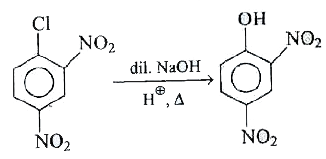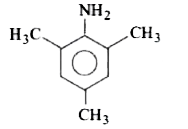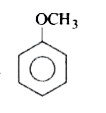Consider the reaction given below. In which cases will the reaction proceed toward right by increasing the pressure ?
4HCl(g)+O2(g)→2Cl2(g)+2H2O(g)
Cl2(g)+H2O(g)→2HCl(g)+12O2(g)
CO2(g)+4H2(g)→CH4(g)+2H2O(g)
N2(g)+O2(g)→2NO(g)
The correct Answer is:A,C
To determine in which cases the reaction will proceed to the right upon increasing the pressure, we can apply Le Chatelier's principle. This principle states that if the pressure of a system at equilibrium is increased, the equilibrium will shift in the direction that has fewer moles of gas.
Let's analyze each reaction step by step:
Step 1: Analyze the First Reaction
Reaction: 4 HCl(g) + O2(g) ⇌ 2 Cl2(g) + 2 H2O(g)
- Total moles of reactants: 4 (HCl) + 1 (O2) = 5 moles
- Total moles of products: 2 (Cl2) + 2 (H2O) = 4 moles
Conclusion: Since the number of gaseous moles of products (4) is less than that of reactants (5), increasing pressure will shift the equilibrium to the right.
Step 2: Analyze the Second Reaction
Reaction: Cl2(g) + H2(g) ⇌ 2 HCl(g) + 0.5 O2(g)
- Total moles of reactants: 1 (Cl2) + 1 (H2) = 2 moles
- Total moles of products: 2 (HCl) + 0.5 (O2) = 2.5 moles
Conclusion: The number of gaseous moles of products (2.5) is greater than that of reactants (2). Therefore, increasing pressure will shift the equilibrium to the left.
Step 3: Analyze the Third Reaction
Reaction: CO2(g) + 4 H2(g) ⇌ CH4(g) + 2 H2O(g)
- Total moles of reactants: 1 (CO2) + 4 (H2) = 5 moles
- Total moles of products: 1 (CH4) + 2 (H2O) = 3 moles
Conclusion: The number of gaseous moles of products (3) is less than that of reactants (5). Thus, increasing pressure will shift the equilibrium to the right.
Step 4: Analyze the Fourth Reaction
Reaction: N2(g) + O2(g) ⇌ 2 NO(g)
- Total moles of reactants: 1 (N2) + 1 (O2) = 2 moles
- Total moles of products: 2 (NO) = 2 moles
Conclusion: The number of gaseous moles of products (2) is equal to that of reactants (2). Therefore, increasing pressure will have no effect on the position of equilibrium.
Final Summary
The reactions that will proceed to the right upon increasing pressure are:
- First Reaction: 4 HCl + O2 ⇌ 2 Cl2 + 2 H2O (correct)
- Third Reaction: CO2 + 4 H2 ⇌ CH4 + 2 H2O (correct)
Reaction: 4 HCl(g) + O2(g) ⇌ 2 Cl2(g) + 2 H2O(g)
- Total moles of products: 2 (Cl2) + 2 (H2O) = 4 moles
Reaction: Cl2(g) + H2(g) ⇌ 2 HCl(g) + 0.5 O2(g)
- Total moles of products: 2 (HCl) + 0.5 (O2) = 2.5 moles
Reaction: CO2(g) + 4 H2(g) ⇌ CH4(g) + 2 H2O(g)
- Total moles of products: 1 (CH4) + 2 (H2O) = 3 moles
Reaction: N2(g) + O2(g) ⇌ 2 NO(g)
- Total moles of products: 2 (NO) = 2 moles
The reactions that will proceed to the right upon increasing pressure are:
- First Reaction: 4 HCl + O2 ⇌ 2 Cl2 + 2 H2O (correct)
- Third Reaction: CO2 + 4 H2 ⇌ CH4 + 2 H2O (correct)
Similar Questions
Knowledge Check
 , this reaction proceed through : Aelectrophilic additionBbenzyne intermediateCnucleophilic aromatic substitutionDoxirane
, this reaction proceed through : Aelectrophilic additionBbenzyne intermediateCnucleophilic aromatic substitutionDoxiraneIdentify 'Z' in the reaction given below :
 A
A B
B C
C D
D
Identify ‘Z' in the reaction given below:
 ACH3CHOB(CH3CO)2OC(CH3)2CHCH2COOHD(CH2ClCO)2O
ACH3CHOB(CH3CO)2OC(CH3)2CHCH2COOHD(CH2ClCO)2O
Complete the reactions given below:

View Solution
By which mechanism does the reaction proceed?
View SolutionAs the reaction proceeds, the rate of reaction:
View SolutionWhich of the following reactions will not be affected by increasing the pressure?
View SolutionWhich of the following reaction will not affected on increasing the pressure ?
View Solution

_E01_318_Q01.png)